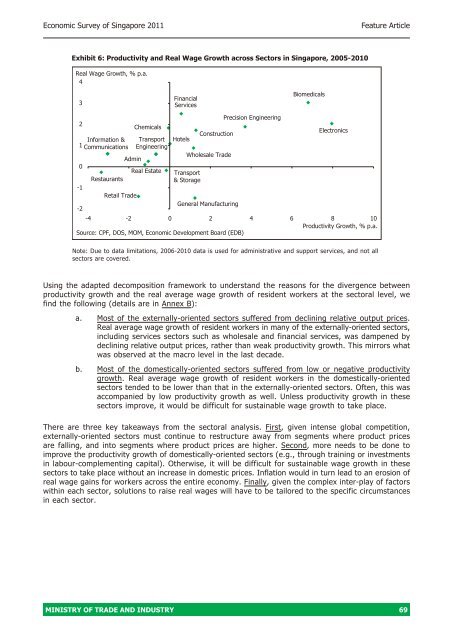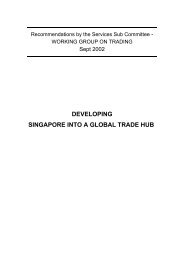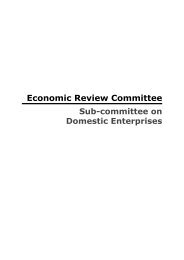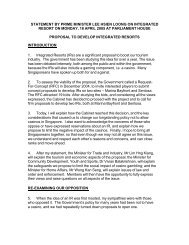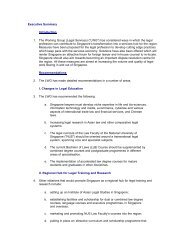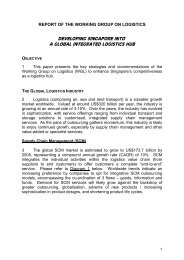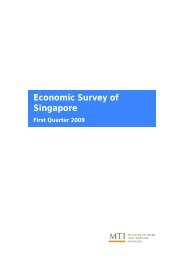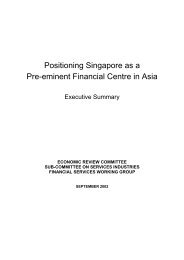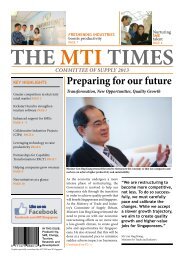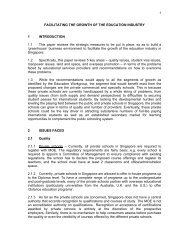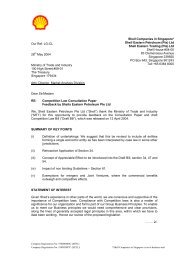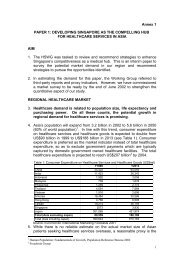Economic Survey <strong>of</strong> Singapore 2011Feature ArticleOne possible reason why output prices failed to keep pace with inflation in the last decade is the intensecompetition faced by our externally-oriented sectors (which make up a sizeable part <strong>of</strong> our economy)in global markets, given the rise <strong>of</strong> low-cost producers like China. This suggests that there is a needto help sectors restructure <strong>and</strong> move up the value chain so that they can produce high VA goods <strong>and</strong>services that can be sold at higher prices in global markets.It is important to note that the above analysis focuses on real average wages, <strong>and</strong> does not take intoaccount the distribution <strong>of</strong> wage growth across worker segments. In reality, if skilled workers arevalued over unskilled workers, the wages <strong>of</strong> skilled workers will grow relative to the wages <strong>of</strong> unskilledworkers. Rising average wages may then not be reflective <strong>of</strong> the extent to which lower-skilled workersare benefiting from productivity growth. Indeed, if we examine the relationship between productivity <strong>and</strong>the real median wages <strong>of</strong> residents in Singapore, we find that it is weaker than that between productivity<strong>and</strong> the real average wages <strong>of</strong> residents (Exhibit 5). This suggests that there are distributional concernsin Singapore, <strong>and</strong> that more effort will be needed to ensure that the fruits <strong>of</strong> productivity gains do notjust benefit the average worker but also workers at the lower end <strong>of</strong> the income spectrum.Exhibit 5: Real Median Wage, Real AME <strong>and</strong> Labour Productivity GrowthIndex, 2000=100125120Productivity115110105100Real AMEReal Median Income95902000 2001 2002 2003 2004 2005 2006 2007 2008 2009 2010Source: CPF, DOS, MOM(II) Analysis at Sectoral Level 10The consensus in the academic literature is that the productivity-wage link at the sectoral level is at bestweakly positive. For example, Montuenga-Gomez et al (2007) observe that while macro studies tend toyield strong correlations between productivity <strong>and</strong> wages, sectoral-level studies yield correlations as lowas 0.1. Graafl<strong>and</strong> <strong>and</strong> Lever (1996) <strong>and</strong> Sharpe et al (2008b) also find that macro factors far outweighthe impact <strong>of</strong> sectoral productivity on sectoral wages in the Netherl<strong>and</strong>s <strong>and</strong> Canada respectively.Likewise, in Singapore, the correlation between productivity <strong>and</strong> real average wage growth is relativelyweak at the sectoral level. Exhibit 6 shows the relationship between the real average wage growth<strong>of</strong> resident workers <strong>and</strong> productivity growth across the various sectors in Singapore over the period2005-2010. 11 While the relationship appears positive, it is much weaker than a one-to-one relationship.For instance, real average wage growth in the electronics sector lagged significantly behind productivitygrowth in the sector. By contrast, the financial services sector saw real average wage growth that wasmuch stronger than productivity growth, while several other sectors (e.g., administrative <strong>and</strong> supportservices, real estate <strong>and</strong> transport engineering) experienced positive real average wage growth eventhough their productivity growth rates were negative.10Unless otherwise stated, SSIC 2005 figures are used for the calculation <strong>of</strong> productivity, wage <strong>and</strong> output price figures for thevarious sectors.11Due to data constraints at the sectoral level, the analysis can only be done for the period 2005-2010.68 MINISTRY OF TRADE AND INDUSTRY
Economic Survey <strong>of</strong> Singapore 2011Feature ArticleExhibit 6: Productivity <strong>and</strong> Real Wage Growth across Sectors in Singapore, 2005-2010Real Wage Growth, % p.a.43FinancialServicesBiomedicals2Information &1 Communications0-1-2RestaurantsAdminRetail <strong>Trade</strong>ChemicalsTransportEngineeringReal EstateHotelsConstructionWholesale <strong>Trade</strong>Transport& StorageGeneral ManufacturingPrecision EngineeringElectronics-4 -2 0 2 4 6 8 10Productivity Growth, % p.a.Source: CPF, DOS, MOM, Economic Development Board (EDB)Note: Due to data limitations, 2006-2010 data is used for administrative <strong>and</strong> support services, <strong>and</strong> not allsectors are covered.Using the adapted decomposition framework to underst<strong>and</strong> the reasons for the divergence betweenproductivity growth <strong>and</strong> the real average wage growth <strong>of</strong> resident workers at the sectoral level, wefind the following (details are in Annex B):a. Most <strong>of</strong> the externally-oriented sectors suffered from declining relative output prices.Real average wage growth <strong>of</strong> resident workers in many <strong>of</strong> the externally-oriented sectors,including services sectors such as wholesale <strong>and</strong> financial services, was dampened bydeclining relative output prices, rather than weak productivity growth. This mirrors whatwas observed at the macro level in the last decade.b. Most <strong>of</strong> the domestically-oriented sectors suffered from low or negative productivitygrowth. Real average wage growth <strong>of</strong> resident workers in the domestically-orientedsectors tended to be lower than that in the externally-oriented sectors. Often, this wasaccompanied by low productivity growth as well. Unless productivity growth in thesesectors improve, it would be difficult for sustainable wage growth to take place.There are three key takeaways from the sectoral analysis. First, given intense global competition,externally-oriented sectors must continue to restructure away from segments where product pricesare falling, <strong>and</strong> into segments where product prices are higher. Second, more needs to be done toimprove the productivity growth <strong>of</strong> domestically-oriented sectors (e.g., through training or investmentsin labour-complementing capital). Otherwise, it will be difficult for sustainable wage growth in thesesectors to take place without an increase in domestic prices. Inflation would in turn lead to an erosion <strong>of</strong>real wage gains for workers across the entire economy. Finally, given the complex inter-play <strong>of</strong> factorswithin each sector, solutions to raise real wages will have to be tailored to the specific circumstancesin each sector.MINISTRY OF TRADE AND INDUSTRY 69


